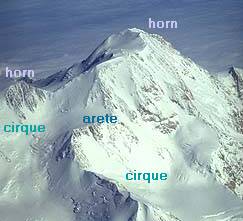Glacial erosion has left us with some spectacular scenery as anyone who has been to Yosemite or Glacier National Park can testify; although most of these features become visible only after the glacier melts. Glaciers erode in two ways: by grinding, when sediments embedded into the ice act like sandpaper; and by plucking, when ice frozen to a rock face pulls out pieces as it moves away from the face. The amount of grinding a glacier can do is dependent on its sediment supply and type as well as the amount of pressure it exerts on underlying materials. That pressure is in turn a function of the thickness of the overlying ice. Plucking is most common where ice moves away from a rock wall rather than flowing over it.
 Erosional features
associated with alpine glaciers are restricted to the valleys in which
the glacier flows. Grinding creates U-shaped valleys the depth and
width of which are proportional to the size of the glacier. Main valleys
will be quite deep. Smaller tributary valleys are less deep than the main
valley. Often left high up on the sides of the main valley, they are called
hanging
valleys. The sharp, knife edged ridges of rock left separating adjacent
valleys are called aretes. In coastal areas where these U-shaped
glacial valleys have been drowned by the ocean subsequent to the melting
of the glacier they are called fjords.
Erosional features
associated with alpine glaciers are restricted to the valleys in which
the glacier flows. Grinding creates U-shaped valleys the depth and
width of which are proportional to the size of the glacier. Main valleys
will be quite deep. Smaller tributary valleys are less deep than the main
valley. Often left high up on the sides of the main valley, they are called
hanging
valleys. The sharp, knife edged ridges of rock left separating adjacent
valleys are called aretes. In coastal areas where these U-shaped
glacial valleys have been drowned by the ocean subsequent to the melting
of the glacier they are called fjords.
The main features caused by plucking are bowl-shaped depressions, called cirques, most often associated with the head of glaciers. If two cirques coalesce and breach the rock wall between them, they will leave a col or saddle. Individual spires of rock left as remnants of plucking are horns.
Because of their large size and thickness (up to two miles), continental glaciers mantle areas and reduce them primarily by grinding. What is left after the glacier has melted is generally a lowered, rolling subdued topography with poor drainage.
Any material which has been transported by a glacier is called drift. Such drift can be deposited directly by ice or secondarily by melt water. Ice-deposited material called till is very distinctive, being poorly sorted and includes all particle sizes from large glacial boulders to the finest silts and clays (rock flour). Sediment reworked and sorted by melt water is called outwash material. Although there are hosts of distinctive glacial depositional landforms, two deserve mention. Moraines are directly deposited by ice and are composed of till, and outwash material is usually deposited farther from the glacier as outwash aprons.